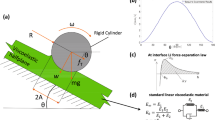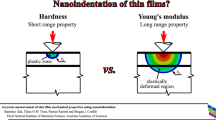Abstract
Rocks and many other materials display a rather complicated, but characteristic, dependence of friction on sliding history. These effects are well-described by empirical rate- and state-dependent constitutive formulations which have been utilized for analysis of fault slip and earthquake processes. We present a procedure for direct quantitative microscopic observation of frictional contacts during slip. The observations reveal that frictional state dependence represents an increase of contact area with contact age. Transient changes of sliding resistance correlate with changes in contact area and arise from shifts of contact population age. Displacement-dependent replacement of contact populations is shown to cause the diagnostic evolution of friction over a characteristic sliding distance that occurs whenever slip begins or sliding conditions change.
Similar content being viewed by others
References
Blanpied, M. L., andTullis, T. E. (1986),The Stability and Behavior of a Frictional System with a Two State Variable Constitutive Law, Pure and Appl. Geophys.124, 415–444.
Blanpied, M. L., Lockner, D. A., andByerlee, J. D. (1991),Fault Stability Inferred from Granite Sliding Experiments at Hydrothermal Conditions, Geophys. Res. Lett18, 609–612.
Bowden, F. B., andTabor, D.,The Friction and Lubrication of Solids, v. 2 (Clarendon, Oxford 1964).
Dieterich, J. H. (1979),Modeling of Rock Friction 1. Experimental Results and Constitutive Equations, J. Geophys. Res.84, 2161–2168.
Dieterich, J. H.,Constitutive properties of faults with simulated gouge. InMechanical Behavior of Crustal Rocks, Geophysical Monograph 24 (eds. Carter, N. L., Friedman, M., Logan, J. M., and Stearns, D. W.) (Am. Geophys. Union, Washington, D. C. 1981) pp. 103–120.
Dieterich, J. H. (1992),Earthquake Nucleation of Faults with Rate- and State-dependent Strength, Tectonophysics211, 115–134.
Dieterich, J. (1994),A Constitutive Law for Rate of Earthquake Production and its Application to Earthquake Clustering, J. Geophys. Res.99, 2601–2618.
Dieterich, J. H., andConrad, G. (1984),Effect of Humidity on Time- and Velocity-dependent Friction in Rocks, J. Geophys. Res.89, 4196–4202.
Dieterich, J. H., andLinker, M. F. (1992),Fault Stability under Conditions of Variable Normal Stress, Geophys. Res. Lett.19, 1691–1694.
Dupont, P., andDunlap, E. (1993),Friction Modeling and Control In Boundary Lubrication, Proc. 1993 American Control Conference, San Francisco, CA, June, 1910–1914.
Evans, B. (1984),The Effect of Temperature and Imurity Content on Indentation Hardness of Quartz, J. Geophys. Res.89, 4213–4222.
Gu, Y., andWong, T.-F. (1991),Effects of Loading Velocity, Stiffness, and Inertia on the Dynamics of a Single Degree of Freedom Spring-slider System, J. Geophys. Res.96, 21677–21691.
Johnson, K. L.,Contact Mechanics (Cambridge University Press, Cambridge 1985).
Kilgore, B. D., Blanpied, M. L., andDieterich, J. H. (1993),Velocity-dependent Friction of Granite over a Wide Range of Conditions, Geophys. Res. Lett20, 903–906.
Kragelskii, I. V.,Friction and Wear (Butterworths, Washington, D. C. 1965).
Linker, M. F., andDieterich, J. H. (1992),Effects of Variable Normal Stress on Rock Friction: Observations and Constitutive Equations, J. Geophys, Res.97, 4923–4940.
Marone, C. J., Scholz, C. H., andBilham, R. (1991),On the Mechanics of Earthquake Afterslip, J. Geophys, Res.96, 8441–8452.
McClintock, F., andArgon, A. S.,Mechanical Behavior of Materials (Addison-Wesley, Reading, Mass. 1966).
Okubo, P. G. (1989),Dynamic Rupture Modeling with Laboratory-derived Constitutive Relations, J. Geophys. Res.94, 12321–12335.
Rabinowicz, E.,Friction and Wear of Materials (John Wiley, New York 1965).
Rice, J. R., andGu, J.-C. (1983),Earthquake Aftereffects and Triggered Seismic Phenomena, Pure and Appl. Geophys.121, 187–219.
Rice, J. R., andRuina, A. L. (1983),Stability of Steady-state Frictional Slipping, J. Appl. Mech.50, 343–349.
Ruina, A. L. (1983),Slip Instability and State Variable Friction Laws, J. Geophys. Res.88, 10359–10370.
Scholz, C. H. (1988),The Critical Slip Distance for Seismic Faulting, Nature336, 761–763.
Stuart, W. D. (1988),Forecast Model for Great Earthquakes at the Nankai Trough Subduction Zone, Pure and Appl. Geophys.126, 619–641.
Tabor, D. (1970),The Hardness of Solids, Rev. Phys. Technol.1, 145–179.
Tse, S. T., andRice, J. R. (1986),Crustal Earthquake Instability In Relation to the Depth Variation of Frictional Slip Properties, J. Geophys. Res.91, 9452–9472.
Tullis, T. E., andWeeks, J. D. (1986),Constitutive Behavior and Stability of Frictional Sliding of Granite, Pure and Appl. Geophys.124, 384–414.
Author information
Authors and Affiliations
Rights and permissions
About this article
Cite this article
Dieterich, J.H., Kilgore, B.D. Direct observation of frictional contacts: New insights for state-dependent properties. PAGEOPH 143, 283–302 (1994). https://doi.org/10.1007/BF00874332
Received:
Revised:
Accepted:
Issue Date:
DOI: https://doi.org/10.1007/BF00874332




